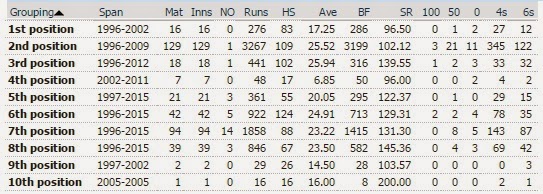Shahid Afridi has left the ODI crease. This time for good. Shahid Afridi retiring from ODI cricket didn’t come as a surprise to me (and if he overturns his decision again, it won’t be a surprise either).
Shahid Afridi's ODI Stats –
When you think of Afridi, the first thing that comes to mind is his 37-ball century. The impact of that innings was so profound that it becomes difficult for a neutral fan to think beyond that innings. But, believe it or not, there’s more to Afridi than that century. For a moment, stop thinking of Afridi as a batsmen and think of him as a bowler who can bat and you start analysing his ODI career stat in a different way!
Stats by batting position –
Stats by bowling position –
One look at the above stats reveal that he has been all over the place. Was he a pure batsmen? Not really sure since he has played in all positions (baring 11th) in the batting line-up with an average of 23.57. Was he a bowler? Yes, 395 wickets in ODI format is not a fluke. Was he a fielder? Someone who debuted in the 1990’s are usually not known to be as good as the fielders of today, but he wasn’t bad either. So, can we safely claim he’s an all-rounder? Statistically, he definitely is. Is he one of the best all-rounders? Debatable.
Afridi started his career as a batsman who can bowl leg-breaks. He ended as a bowler who can bat a bit. His initial batting success raised expectations from him (more so being from Asia where Cricket is the biggest religion) and he never stood up to those expectations vis-à-vis batting. But he was always a joker-in-the-pack. You never know when he makes a difference.
Personally, I have been a huge fan of Shahid Afridi. What makes Afridi special for me is the time he made his ODI debut. If we recollect, mid-1990’s was a time when ODI cricket was undergoing a paradigm shift. Some players, including Sanath Jayasuriya (predominantly a bowler who was given the responsibility to bat as an opener) and Shahid Afridi, were changing the way batsmen were batting. Risk taking, attacking the opposition in the first 15 overs during the fielding restriction were emerging as a key weapon to get a heads-up on the opposition. We remember Jayasuriya as the key proponent of that change. Very few remember Afridi for playing a key part. For a neutral fan, there’s never a dull moment when he’s batting. There are only two modes – boom boom or bust! And that’s the only thing that made me sit and watch his batting whenever I got the opportunity.
Only 3 players in ODI cricket have scored more than 8000 runs and taken more than 250 wickets…
… and Afridi is in that list, behind only Kallis and Jayasuriya!
For me, Afridi will remain an enigma. He was always the danger man when he’s at the crease – either to the opposition or sometimes to his own team. His last innings was testament of the latter. Five wickets down for 100-odd runs, Afridi arrived at the crease, Pakistan needed Afridi to apply himself, rotate strike, build a partnership and steady the ship. Afridi, however, played a typical “Afridi-sque” innings of 15-ball 23 and departed, much to the disappointment of Pakistani fans. But hey, that’s the only way he plays!
Shahid Afridi, thank you for entertaining 18 years. Cricketing world will surely miss an unpredictable and enigmatic character like you.
PS: all statistical data queried and taken from statsguru, courtesy espncricinfo,com.





